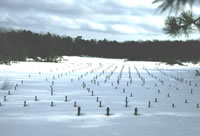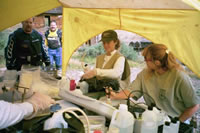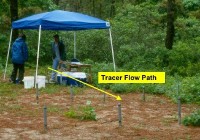Toxic Substances Hydrology (Toxics) Program scientists use tracer tests to learn more about the transport and fate of contaminants in the environment. By placing a known concentration and amount of tracer in ground water or in a stream and monitoring the movement of the tracer, scientists can test hypotheses on the processes that control the transport and fate of many different types of contaminants. In many cases, changing natural systems and watching the response is one of the most efficient ways to learn how contaminants move in ground water or streams. The Toxics Program’s extensive use of tracer tests is unique when compared to other environmental research programs. Many Toxics Program investigations have used tracer tests as part of their investigation. The information presented on this page cuts across lines drawn by individual investigations and projects so that information on tracer tests conducted by the Toxics Program can be presented in one place.
Investigations and Research Activities
Fact Sheets
|

Multilevel well-sampling array at the Cape Cod Research Site, MA, where many natural gradient tracer tests have been conducted. There are over 10,000 subsurface sampling ports.
(Larger Version)
Headlines

Processing samples during a stream tracer test on California Gulch, Animas River, CO
(Larger Version)
Bibliography
New Publications
Upcoming Publications
- Application of iron and zinc isotopes to track the sources and mechanisms of metal loading in a mountain watershed: Borrok, D.M., Wanty, R.B., Ridley, W.I., Lamothe, P.J., Kimball, B.A., Verplank, P.L., and Runkel, R.L., Applied Geochemistry (IN PRESS).
- The use of fluoride as a natural tracer and the relationship to geologic features--Examples from the Animas River Watershed, San Juan Mountains, Colorado: Bove, D.J., Walton-Day, K., and Kimball, B.A., Geochemistry--Exploration, Environment, and Analysis (IN PRESS).
Newly Published
- Multi-scale measurements and modeling of denitrification in streams with varying flow and nitrate concentration in the Upper Mississippi River Basin, USA: Böhlke, J.K., Antweiler, R.C., Harvey, J.W., Laursen, A.E., Smith, L.K., Smith, R.L., and Voytek, M.A., 2009, Biogeochemistry, v. 93, p. 117-141, doi:10.1007/s10533-008-9282-8 (Advanced Web release).
- A simple technique for continuous measurement of time-variable gas transfer in surface waters: Tobias, C.R., Böhlke, J.K., Harvey, J.W., and Busenberg, E., 2009, Limnology and Oceanography--Methods, v. 7, no. 2, p. 185-195 (Journal table of contents with pdf links).

A tracer solution of 15N-enriched ammonium was injected upgradient of
several multilevel sampling wells during a natural-gradient tracer test designed to assess the
fate and transport of ammonium in a sewage plume on Cape Cod, Mass.
(Larger Version)
Meetings and Conferences
|